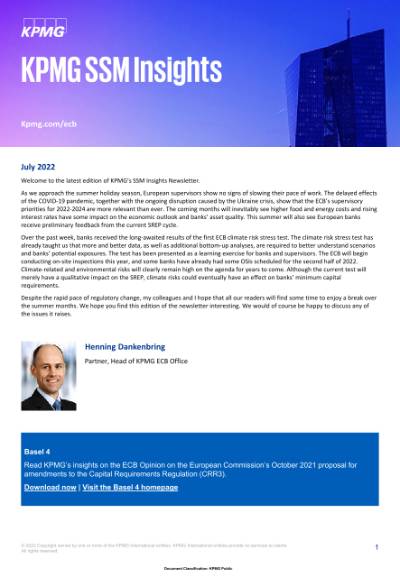July 2022
By now, most European banks should be familiar with the EU’s 6-pillar Action Plan on the prevention of money laundering and terrorist financing, published in May 2020. The plan is due to be implemented via a package of four legislative proposals, which anticipate the creation of:
1. A new Anti-Money Laundering Authority (AMLA), with both direct and indirect supervisory authority for anti-money laundering and countering terrorist financing (AML/CFT). The AMLA will be established via Anti-Money Laundering Authority Regulation (AMLAR)
2. A new AML/CFT Single Rulebook, which will be established via:
- Anti-Money Laundering Regulation (AMLR1)
- The 6th Directive on Combating Money Laundering and Terrorist Financing (AMLD6)
- Amendment of the Fund Transfer Regulation focussed on crypto/virtual assets
Taken together, these proposals promise to strengthen and modernise the EU’s approach to AML/CFT. They will create a more granular legal framework, and one which - in view of the two regulations - will be directly applicable across the EU. Central oversight and supervision will be much stronger than at present.
AMLA, which is the centrepiece of the integral oversight, is mandated with both direct supervision of high-risk financial institutions and indirect supervision over the financial and non-financial sector.
For institutions not directly supervised by AMLA, the practical execution of AML/CFT supervision will be largely delegated to National Competent Authorities (NCAs). Even so, AMLA’s mandate includes several major competencies which have high relevance for non-directly supervised entities. These competencies include, inter alia, taking over the supervision of an individual financial entity in the event of relevant AML/CTF issues, and coordinating national supervision with the goals of:
- Increasing the effectiveness of enforcement for the AML/CTF Single Rulebook; and
- Issuing AML/CFT regulatory and implementing technical standards, guidelines and recommendations, which will be binding on the NCAs executing supervision.
The number of entities that will be directly supervised by AMLA has been initially estimated at 12 to 20 institutions across Europe. However, AMLA’s indirect supervisory mandate and its standard-setting role will certainly solidify it as the EU’s leading AML/CTF authority, overseeing all obliged entities within the whole financial and non-financial sectors. All institutions and undertakings – even if they expect to be excluded from the circle of 12 to 20 directly supervised organisations - need to recognise AMLA’s importance also for them and prepare accordingly.
It is notable that the supervisory powers of AMLA, and the institutions within its direct and indirect remit, overlap with the supervisory activities of the ECB in several areas.
This overlap between the responsibilities and powers of AMLA and the ECB is a reason why the ECB is taking a close interest in the development of the new AML/CFT regime and the establishment of AMLA as supervisory authority.
The overlap between AML/CFT supervision by AMLA and prudential supervision by the ECB, most prominently occurs in the following areas of dual competencies, including:
- Granting and withdrawing banking licences
- Approving acquisitions of qualifying shareholdings
- Conducting fit and proper assessments of board members incl. the power to require changes
- Assessing the appropriateness of AML/CTF governance related elements which then feature in the ECB’s SREP assessment and the potential SREP surcharge determination.
AMLA’s power to impose binding decisions on supervised institutions, along with administrative sanctions of up to a maximum of 10% of turnover or €10 million (whichever is higher) represents a sharp sword that reflects the European Commission's determination to fight money laundering and terrorist financing, and underlines the rigour of the EU’s new AML/CFT regime.
When considering these areas of AMLA’s supervisory powers, it is apparent that AMLA’s emergence as a supervisory authority on European level will have a direct bearing on many of the ECB’s prudential supervisory tasks. In a speech1 as recent as 22 June 2022 Elizabeth McCaul, ECB Representative to the Supervisory Board, pointed out that “although ECB’s supervisory role is solely prudential, the EU framework envisages an enhanced role for prudential supervisors in AML/CTF”. She listed AMLD5, CRD V and the EBA’s Guidelines and regulatory technical standards as some of the sources of prudential supervisors’ own AML/CTF related competencies.
While positively embracing the establishment of AMLA as new supervisory authority, the ECB encourages to take modifications to the regulations defining AMLA’s activities. In doing so, the ECB’s stated goals are to:
- Achieve active co-operation between AMLA and the EBA (as well as ESMA and EIOPA) over the formulation of regulatory guidelines or technical standards and the exchange of information in areas of shared competence
- Create a co-ordination mechanism to avoid contradiction, confusion or unintended consequences in the execution of prudential and AML/CFT supervisory powers
- Extend and introduce objective selection criteria. This would avoid stigmatizing the 12 to 20 institutions selected for direct AMLA supervision as AML/CTF high risk pursuant to supervisors’ internal assessment but allow for a selection that does not disclose internal supervisory confidential risk assessments and broaden the number of directly supervised institutions.
- Broaden AMLA’s powers of indirect supervision to foster consistency across the EU, with NCAs asked to take supervisory action if required - including using risk-based categories to ensure proportionality and efficiency. This would further strengthen AMLA’s influence on all SSM banks, not just those under direct AML/CFT supervision.
- Avoid the creation of an additional reporting layer, for example by facilitating data sharing between AML/CFT and prudential supervisors by leveraging existing supervisory data hubs.
Banks and other financial institutions should be aware that the ECB’s input could lead to AMLA directly supervising more banks than currently anticipated, and to AMLA having a greater indirect impact on other SSM banks than initially foreseen.
Although it is impossible to predict what effect the ECB’s recent opinions will have on the EU’s new AML/CFT regime, two relevant conclusions could be drawn:
- First, that the ECB is aware that a new and equally powerful supervisory authority is entering the European stage, and now is the time to ensure the framework will achieve effective cooperation between both authorities.
- Second, that AML/CTF obliged parties (both financial and non-financial) should anticipate a similar increase in AML/CTF regulation as it was observable in the prudential regulatory area by indirectly supervised entities when the ECB became the EU’s leading prudential supervisor, and as it extended the scope and granularity of its activities over subsequent years.
Stay up to date with what matters to you
Gain access to personalized content based on your interests by signing up today
Connect with us
- Find office locations kpmg.findOfficeLocations
- kpmg.emailUs
- Social media @ KPMG kpmg.socialMedia
Related content
1. https://www.bankingsupervision.europa.eu/press/speeches/date/2022/html/ssm.sp220622_1~e71526b24b.en.pdf





